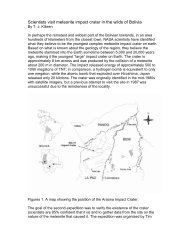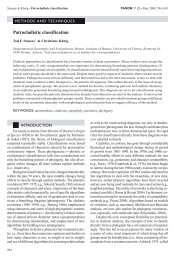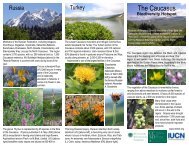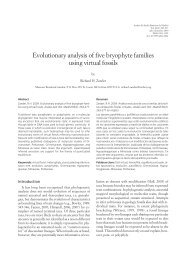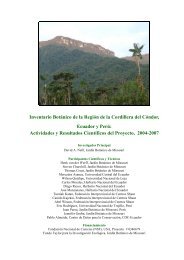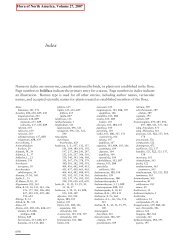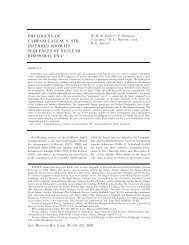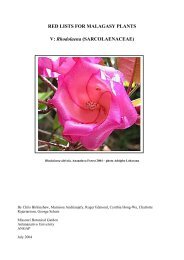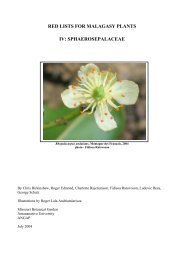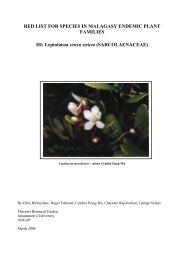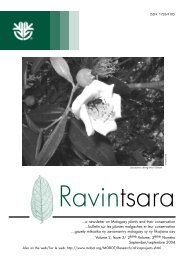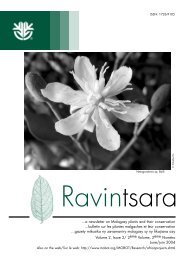re-evaluation of tortella - Missouri Botanical Garden
re-evaluation of tortella - Missouri Botanical Garden
re-evaluation of tortella - Missouri Botanical Garden
Create successful ePaper yourself
Turn your PDF publications into a flip-book with our unique Google optimized e-Paper software.
throughout the seacoast <strong>of</strong> the Netherlands, especially<br />
between Voorne and Schoorl, whe<strong>re</strong>as that <strong>of</strong> the var.<br />
flavovi<strong>re</strong>ns is known only from four localities. In the<br />
Netherlands, the leaf cell size <strong>of</strong> var. flavovi<strong>re</strong>ns is 8–10<br />
µm whe<strong>re</strong>as that <strong>of</strong> var. glariecola is much larger: 10–<br />
14 µm. Based on a <strong>re</strong>port by Townsend (1965) <strong>of</strong><br />
sporophyte material <strong>of</strong> the var. glariecola found on the<br />
island <strong>of</strong> Cyprus, the<strong>re</strong> is also an appa<strong>re</strong>nt diffe<strong>re</strong>nt in<br />
the spo<strong>re</strong> size (Rubers 1973). That American<br />
populations <strong>re</strong>p<strong>re</strong>sent only the var. flavovi<strong>re</strong>ns, even<br />
though the leaf cells a<strong>re</strong> on average larger (to 12 µm<br />
with some cells <strong>re</strong>aching 14 µm), may indicate that the<br />
American populations a<strong>re</strong> depauperate. The issue<br />
<strong>re</strong>qui<strong>re</strong>s further study.<br />
Braunmiller et al. (1971) state that the center <strong>of</strong><br />
dispersal in Europe is the Mediterranean <strong>re</strong>gion whe<strong>re</strong><br />
the species is broadly distributed and common, with<br />
scatte<strong>re</strong>d outposts along the western European coast to<br />
Denmark and England.<br />
The species forms a suite with other<br />
Mediterranean Tortellas: T. inflexa and T. nitida. These<br />
authors seem to indicate that only in the northwest <strong>of</strong><br />
Europe does the<strong>re</strong> occur two varieties <strong>of</strong> Tortella<br />
flavovi<strong>re</strong>ns, the typical one and the var. glariecola.<br />
They also suggest that the only German <strong>re</strong>ports <strong>of</strong> T.<br />
flavovi<strong>re</strong>ns a<strong>re</strong> those <strong>of</strong> the typical variety.<br />
Stations outside <strong>of</strong> North America a<strong>re</strong> based on<br />
published <strong>re</strong>ports. The species has such a large <strong>re</strong>ported<br />
world distribution, in addition to the Atlantic and the<br />
Mediterranean, that one might even expect it on tropical<br />
or subtropical coasts <strong>of</strong> Pacific North America (A.C.<br />
Crundwell, pers.comm.) unless cold ocean cur<strong>re</strong>nts<br />
p<strong>re</strong>clude this.<br />
In the United States, all specimens <strong>of</strong> Tortella<br />
flavovi<strong>re</strong>ns that we<strong>re</strong> inland from coastal habitats we<strong>re</strong><br />
<strong>re</strong>determined to be some other species: T humilis most<br />
f<strong>re</strong>quently, Trichostomum crispulum and Weissia spp.<br />
The fact that Tortella flavovi<strong>re</strong>ns is salt-tolerant may be<br />
helpful in excluding taxa, such as T. inclinata, from<br />
similar habitats. In Europe, the range <strong>of</strong> T. flavovi<strong>re</strong>ns is<br />
thought to overlap that <strong>of</strong> T. inclinata. However, if T.<br />
flavovi<strong>re</strong>ns is an obligate halophyte and T. inclinata is<br />
intolerant <strong>of</strong> salty conditions, the ranges may be me<strong>re</strong>ly<br />
contiguous.<br />
Crum and Anderson (1981: 306) <strong>re</strong>ported that<br />
"Nyholm [1956: 137] included in the species'[sic] range<br />
Macaronesia, North Africa, the Middle East, China, and<br />
Japan." Noguchi (1988), however, did not include it in<br />
the moss flora <strong>of</strong> Japan, nor did Redfearn (1993) for<br />
China. Fife (1995), however, <strong>re</strong>ported it from New<br />
Zealand whe<strong>re</strong> it had been known as T. rubripes (Mitt.)<br />
Broth., a species p<strong>re</strong>viously thought to be endemic to<br />
New Zealand. It was described by Sainsbury (1955) as<br />
an "exclusively...maritime plant" which "can properly<br />
be described as a halophyte, its station being at<br />
practically the edge <strong>of</strong> the sea. It is widely distributed<br />
on the coast in the Auckland District, and appears he<strong>re</strong><br />
and the<strong>re</strong> as far south as the Mahina Peninsula, Hawke's<br />
Bay."<br />
10<br />
The characteristic pale yellow leaves (versus<br />
the mo<strong>re</strong> opaque and sordid yellow- or bright g<strong>re</strong>en <strong>of</strong><br />
T. humilis and T. inclinata) is indicated in the epithet.<br />
Dixon (1924) cited Limpricht (1890) as diffe<strong>re</strong>ntiating<br />
between Tortella flavovi<strong>re</strong>ns and T. inclinata, whose<br />
ranges overlap in G<strong>re</strong>at Britain, by the p<strong>re</strong>sence <strong>of</strong> a<br />
stem central strand in the former, and its absence in the<br />
latter. "In undoubted [Tortella] flavovi<strong>re</strong>ns from our<br />
coasts, however, I find the central strand enti<strong>re</strong>ly absent,<br />
and the stem in section exactly similar to that <strong>of</strong> [T.]<br />
inclinata" (Dixon 1924). Smith (1978) stated that T.<br />
flavovi<strong>re</strong>ns "<strong>of</strong>ten" has a stem central strand. In material<br />
examined from the southeastern United States, the stems<br />
<strong>re</strong>gularly had a distinct central strand.<br />
The leaf cross section <strong>of</strong> Tortella flavovi<strong>re</strong>ns<br />
exhibits an adaxial layer <strong>of</strong> quadrate, papillose cells<br />
across its surface throughout the leaf length excepting<br />
the proximal <strong>re</strong>gion and the ext<strong>re</strong>me apex. In section,<br />
the leaf is keeled beside the costa, then widens broadly<br />
out befo<strong>re</strong> widely curving inwards in the shape <strong>of</strong> a<br />
caliper or tongs. The leaf cross section <strong>of</strong> T. humilis is<br />
generally flat with the margins shortly and slightly e<strong>re</strong>ct<br />
or somewhat incurved, becoming mo<strong>re</strong> curved or<br />
slightly keeled in the apical ext<strong>re</strong>mities whe<strong>re</strong> an<br />
absence <strong>of</strong> the adaxial quadrate layer is f<strong>re</strong>quent.<br />
Tortella flavovi<strong>re</strong>ns shows g<strong>re</strong>at variability in<br />
the apex; on the same stem some apices may have<br />
costae subpercur<strong>re</strong>nt and the apices a<strong>re</strong> round in outline,<br />
or they may be flat to sharply tubulose and have<br />
percur<strong>re</strong>nt costae, or they can be narrowly acute with a<br />
strong mucro, but always at least some <strong>of</strong> the apices a<strong>re</strong><br />
naviculate and f<strong>re</strong>quently most a<strong>re</strong> cucullate. The<br />
species shows mo<strong>re</strong> variability in Europe, with cucullate<br />
apices in some populations to flat apices in others, but<br />
all with e<strong>re</strong>ct to incurved margins, lack <strong>of</strong> tomentum,<br />
larger leaf cells, and central strand p<strong>re</strong>sent.<br />
The proximal cell <strong>re</strong>gion in larger leaves is<br />
sharply distinguished from the distal laminal <strong>re</strong>gion by<br />
abruptly elongated smooth cells in contrast with the<br />
distal quadrate papillose cells. However, in many<br />
smaller leaves the transition is completely gradual in<br />
cell size and cell wall thickness such that the V-shaped<br />
<strong>re</strong>gion is defined mo<strong>re</strong> by the papillae than by the cell<br />
dimensions, and the proximal margin has a border <strong>of</strong><br />
mo<strong>re</strong> abruptly elongated proximal cells. This may<br />
account to some extent for European published <strong>re</strong>ports<br />
<strong>of</strong> the taxonomic proximity <strong>of</strong> this species with Tortella<br />
nitida, which has gradually transitional cells in all <strong>of</strong> its<br />
leaves with a sometimes poorly defined proximal<br />
marginal border <strong>of</strong> elongate cells. This situation is also<br />
rather characteristic <strong>of</strong> Tortella humilis and may align<br />
these th<strong>re</strong>e species, together with the leaf shape, stem<br />
central strand and undiffe<strong>re</strong>ntiated perichaetial leaves.<br />
The peristome <strong>of</strong> Tortella flavovi<strong>re</strong>ns is<br />
somewhat short, but not rudimentary: it is about half the<br />
size <strong>of</strong> that <strong>of</strong> T. humilis, for example, and is appa<strong>re</strong>ntly<br />
an example <strong>of</strong> <strong>re</strong>duction for the genus in North<br />
America. It is e<strong>re</strong>ct or somewhat inclined and<br />
<strong>re</strong>miniscent <strong>of</strong> Trichostomum peristomes, which a<strong>re</strong>





